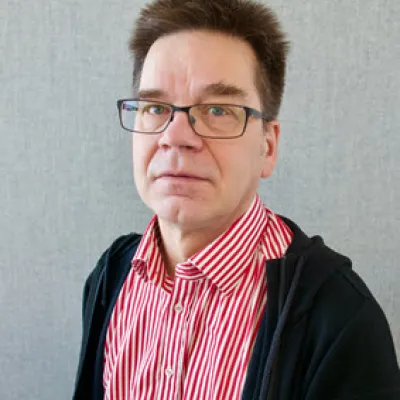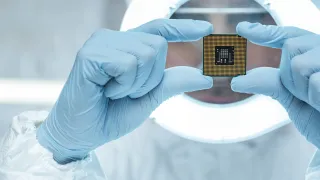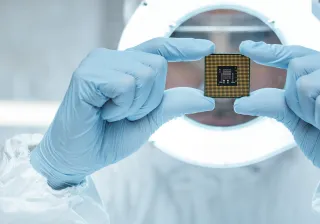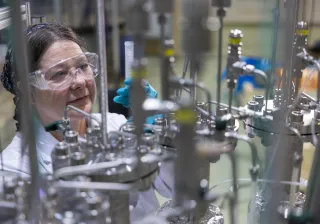In microelectronics, most of the products come from the Far East, but in various special fields Finland holds a pioneering position in research and development.
As of the beginning of next year, VTT will unite all its research teams dealing with microelectronics into a new Microelectronics Research Area, headquartered in the Micronova building on Tietotie 3 in Otaniemi. The VTT facilities there include not only research laboratories but also cleanroom facilities for manufacturing microelectronics components with about 20 external corporate users. The VTT subsidiary VTT Memsfab offers small scale production services to corporate customers.
– The sector is very capital-intensive, and small startups lack sufficient own funding needed for acquiring laboratories and cleanrooms. We help these companies grow by providing them with infrastructure and other services, says Tauno Vähä-Heikkilä, Vice President, Microelectronics Research Area at VTT.
VTT's networks also give Finnish companies access to international research projects within the field.
Cross-cutting technology
Microelectronics is used in many sectors. As cross-cutting technology, it does not have one spearhead area of application, but it is used in many highly competed sectors. The Finns do not compete in the manufacturing of logic and memory circuits, where the investments in plants are counted in billions and the playing field is dominated by a few major conglomerates operating in the Far East.
VTT has almost 200 people working with microelectronics, with R&D being done in such fields as space technology, photonics, quantum technologies, radio and millimetre wave areas, and microelectromechanical systems (MEMS).
– Different sensor technologies, such as hyperspectral cameras and radars, have also been in strong growth in recent years. These technologies have been driven by mobile phones and IoT technologies, where the number of sensors has been increasing in recent years, as it also has in the industrial sector. The major drivers today include electrification and automation of vehicles. The markets of health and welfare applications are also expected to grow rapidly, says Jyrki Kiihamäki, Co-Creation Manager.
Finnish microelectronics clusters have already emerged in such areas as radiation detectors, instruments related to imaging in dental medicine and atomic layer deposition. Quantum technologies are also bringing revenues to Finland.
– As prototypes for quantum computers are being presented in the world, they all feature Finnish Bluefors' cooling systems, which reach temperatures near absolute zero. At Micronova, we can also manufacture superconducting components, which are used in quantum technology devices, Vähä-Heikkilä says.
Even many quite big corporate users of microelectronics, such as Nokia and Huawei, have R&D activities in Finland. Among Finnish consumer brands, Suunto and Polar strongly rely on microelectronics.
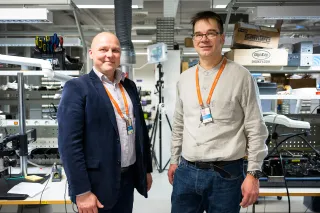
Space operations growing fast
One sector that has grown particularly fast in recent years is commercial use of space technology.
– Finland has several big traditional companies operating in the space industry. In addition, a lot of small enterprises have recently emerged in the New Space theme area. They have their own satellites with payloads manufactured in Finland as well, Vähä-Heikkilä says.
The satellites are not launched from Finland, but the launches are made by commercial services available in different parts of the world, for example, in the United States and India. The satellites are no longer as big as cars, but closer to the size of a milk carton, and there are much more of them than before. This development allows launches of small payloads and new applications.
– Some telecommunications companies are planning satellite constellations that would cover the entire globe. The idea is to achieve higher data transfer speeds and lower latencies and, in the last resort, lower service prices for end users, Vähä-Heikkilä says.
Small satellites orbit the world faster than larger ones, so, when using them, it is also possible to get information faster on the desired spot, such as in the event of natural catastrophes or when monitoring oil spills in shipping. Satellites can also be used for verifying carbon dioxide emissions and sequestration of carbon dioxide to enable emissions trading.
– Small satellites ensure communications connections to ships, airplanes and sparsely populated areas. Typically, these satellites have low orbits, so they can be burnt away in the atmosphere towards the end of their life cycles, Kiihamäki says.
MilliLab measurements available only from VTT
One of the key roles in the development of Finnish space technology is held by MilliLab, the joint laboratory of VTT and Aalto University. It also serves as the European Space Agency (ESA) External Laboratory.
MilliLab focuses on the technologies and services in the millimetre wavelength range in particular. Some of the measurements performed by MilliLab cannot be acquired anywhere else in the world but from VTT.
– In addition to serving ESA, we provide a lot of measurement services to European industries and other operators as well. In the affairs of the millimetre wavelength range, we are presently the only commercial service provider in the world, Vähä-Heikkilä says.
A large share of MilliLab's operations focus on space qualification, aimed at studying in advance whether the electronics being launched to space will stand not only the launch phase of the satellite and the space environment but also long-term storage before the space launch.
VTT has also payloads of its own in space; for example, at the moment, there are two hyperspectral cameras photographing the globe in different wavelength ranges. Next year, we will see the launch of the first ESA 5G satellite W-Cube.

